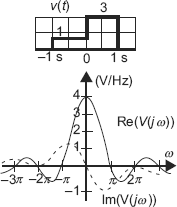14.5 SYMMETRY PROPERTIES OF FOURIER TRANSFORMS
There is nothing wrong mathematically inv(t) possessing an imaginary part. However, it will not be a physical waveform then. We deal with physical waveforms in Circuit Theory. Hence, we deal with real functions of time exclusively. The Fourier transform of a real v(t) has many interesting symmetry properties.

Fig. 14.4-10 Waveform and Spectra for Example 14.4-5
14.5.1 Conjugate Symmetry Property
Let v(t) be a real function of t and V(jω) its Fourier transform. Then, V(–jω) = V*(jω). This can be shown as follows:
This implies that Re(V(–jω)) = Re(V(jω)) and Im(V(–jω)) = –Im(jω). It also ...
Get Electric Circuits and Networks now with the O’Reilly learning platform.
O’Reilly members experience books, live events, courses curated by job role, and more from O’Reilly and nearly 200 top publishers.

